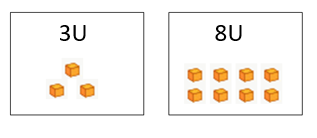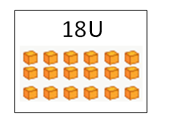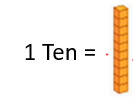In today’s post, we are going to review Units, Tens, Hundreds, and see some examples of how they are used.
Units
It is the smallest natural number. We are going to represent a unit with a cube:
![]()
To abbreviate the word unit, we will write U, for example:
 Tens
Tens
Let’s look at a larger number of units:
There are a lot of units, right? Well, imagine how many there would be if we use an even bigger number of them!
Because of this, we use the tens which groups the units into groups of 10:

We are going to represent the number 18 using tens and units. You should know that we abbreviate ten with the letter T. As shown:
A ten is a greater value than a unit. A ten is composed of 10 units. Here are other examples:
 Hundreds
Hundreds
But the same thing happens when we get to 100. For example, look at how the number 101 would be represented with tens and units:

Therefore, we use the hundred which equals 10 tens or, which is the same as 100 units:

We abbreviate hundred with the letter H. Here are two examples:
 Positional Value
Positional Value
Now that we are familiar with the units, tens, and hundreds, we are going to look at the positional value of the numbers.
We are going to organize the numbers we have seen in a table, according to these instructions:
- In the left-hand column, we write the complete number.
- In the three next columns, where it says H, T and U, we have to figure out the number, writing only one digit in each cell, always the last number in the units.
- In the last column, we express the number as the sum of its placeholder values.

Did our lesson help you to better understand units, tens, and hundreds?
If you want to continue practicing, we have a lot of these types of exercises on Smartick… And much more! Try it for free.
Learn More:
- Learn Multiplication Algorithm Using Blocks
- Review Addition Algorithm and Vertical Addition with Carrying
- Tens and the Decimal Number System
- Different Methods of Multiplication
- Review Vertical Subtraction with Examples








Nice work
Did it very well to better understand
Nice 👍 work publish more of this kind
Amazing,it helps me understand better when I need to teach my students
hi guys😄😍🤗🤪
Thank you for d simple explanation
Thank you, I appreciate it.
Thanks great lesson
Thanks 🙏
Education is the process to achieve your goal. And the more you learn, the more thing you will know, the more you know the more places you wil go. Learning is the lighterning way to get you into sucess.
Interested, I want to learn more.
Some teachers say that 10 items in a bundle are called a unit
Am getting confused coz according what I learned from different schools up to my college level, a unit is an individual item and in the case of 10 items it means I have ten units
Nice
Great
I love this, it helps me to assist my kids
Very helpful and easy when teaching really enjoyed. 👏great job.
Very helpful God bless u all!!.
Wow!!
I love this diving it help me to teach my pupils
waoooo…this is simply simplified. ..I love it ,I use it to teach my son,it’s so helpful, bravo to smartick
Interested
I want to learn more about maths
So interested and ok
I love this and I think it will help me to teach my pupils in the class.
I love math
So helpful.
Simple, understandable and straight to the point. It greatly assisted my daughter to understand this section of elementary maths. Kudos to Smartick once again!!!
Good to hear 🙂
Wow so interesting it helps me alot kudos smartick.
i love maths
Units with examples
same i like maths
Wooow it help me I love it
I love math
So do we at Smartick!
It’s incredibly important to know Maths…
It has been very helpful to me in terms of teaching my child.
I love it!! Thanks
It’s indeed amazing and interesting write up, useful to our younger ones. Cheers
This is great information to help children understand number values and placement. Thanks!
Thanks so much, it help me to teach my son.
thanks
helpful
It was very useful. Thank you so much. It helped me to teach my students in easily manner.
Thanks, it helps my son.
I will teach my dear son thank u
This is a most useful contribution to the debate
Self explanatory
Nice